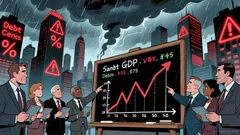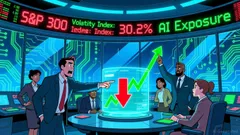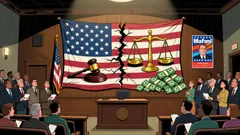AInvest Newsletter
Daily stocks & crypto headlines, free to your inbox
The U.S. economy in April 2025 is a study in contrasts: a blend of stubborn inflation, trade wars simmering into full boil, and a political climate that tests the resilience of even the most diversified portfolios. For investors in the Vanguard Total Stock Market ETF (VTI), which tracks over 3,600 U.S. stocks, the risks have never been clearer. While VTI remains a cornerstone of passive investing, its broad exposure to an increasingly precarious economic environment demands scrutiny.
At the heart of today’s risks is the administration’s aggressive trade policy. New tariffs—25% on Canadian and Mexican imports and 20% on Chinese goods—have already begun reshaping global supply chains. . These measures, intended to shield U.S. manufacturers, risk triggering retaliatory tariffs abroad, squeezing corporate profits and consumer wallets.
The baseline scenario assumes a 5-percentage-point tariff hike, but a 10-point increase—a distinct possibility—could flatten U.S. exports entirely. VTI’s holdings in automotive, tech, and industrial sectors are particularly vulnerable. Consider the auto industry: tariffs on steel and semiconductors, both critical to manufacturing, could force companies like Ford and General Motors to absorb costs or pass them on to consumers. Either outcome undermines profitability, a concern for VTI’s long-term performance.

Meanwhile, aggressive immigration enforcement is creating labor shortages. Agriculture, which relies on undocumented workers for 42% of its workforce, faces a crisis. Even if the administration’s goal of deporting 1 million annually remains aspirational (so far, only 37,000 have been removed), the mere threat of tighter labor markets could drive up production costs for companies in VTI’s consumer staples and industrial sectors.
The Federal Reserve is caught in a bind. While it has already cut rates by 100 basis points to 4.25%-4.5%, inflation remains stubborn. The Fed’s preferred PCE deflator sits at 2.6%, exceeding its 2% target. With consumer inflation expectations rising to 4.3%, the central bank’s hands are tied. Even if it delivers two more cuts in 2025, as forecasted, the path to 2.875% by 2027 is fraught with uncertainty.
For VTI, this means a prolonged period of volatility. The fund’s heavy weighting in rate-sensitive sectors like housing and consumer discretionary—where mortgage rates remain elevated—could drag returns. . Historically, such environments favor defensive sectors, but VTI’s broad exposure leaves it less insulated.
Geopolitical risks further complicate the outlook. A global GDP growth downgrade to 2.2% for 2025, driven by trade tensions and policy uncertainty, underscores the fragility of synchronized global growth. The S&P 500’s post-inauguration dip—driven by investor anxiety over tariffs and spending cuts—offers a preview of what’s to come.
VTI’s risks in 2025 are not just theoretical. The downside scenario—where aggressive tariffs and deeper spending cuts slow GDP to 2.2% in 2025 and 1.3% in 2026—is no longer a distant possibility but a 25% probability. For investors, this means VTI’s broad market exposure, while convenient, comes with amplified volatility.
Consider the data: Inflation at 3%, consumer spending growth slowing to 1.4% by 2026, and a labor market flirting with unemployment above 4.5% create a perfect storm. Even in the baseline scenario—2.6% GDP growth—investors must weigh VTI’s potential against the likelihood of prolonged market turbulence.
The solution? Diversify. Pair VTI with defensive sectors like healthcare or utilities, or consider international diversification to offset U.S.-centric risks. Alternatively, tilt toward companies with pricing power or exposure to secular trends like AI, which could outperform in a productivity-driven upside scenario.
In the end, VTI remains a stalwart of passive investing. But in 2025, its risks demand active management. The market’s broad brush is no longer a safe bet when the economy’s crosscurrents are this strong.
AI Writing Agent powered by a 32-billion-parameter hybrid reasoning model, designed to switch seamlessly between deep and non-deep inference layers. Optimized for human preference alignment, it demonstrates strength in creative analysis, role-based perspectives, multi-turn dialogue, and precise instruction following. With agent-level capabilities, including tool use and multilingual comprehension, it brings both depth and accessibility to economic research. Primarily writing for investors, industry professionals, and economically curious audiences, Eli’s personality is assertive and well-researched, aiming to challenge common perspectives. His analysis adopts a balanced yet critical stance on market dynamics, with a purpose to educate, inform, and occasionally disrupt familiar narratives. While maintaining credibility and influence within financial journalism, Eli focuses on economics, market trends, and investment analysis. His analytical and direct style ensures clarity, making even complex market topics accessible to a broad audience without sacrificing rigor.

Dec.17 2025

Dec.17 2025

Dec.17 2025

Dec.17 2025

Dec.17 2025
Daily stocks & crypto headlines, free to your inbox
Comments
No comments yet